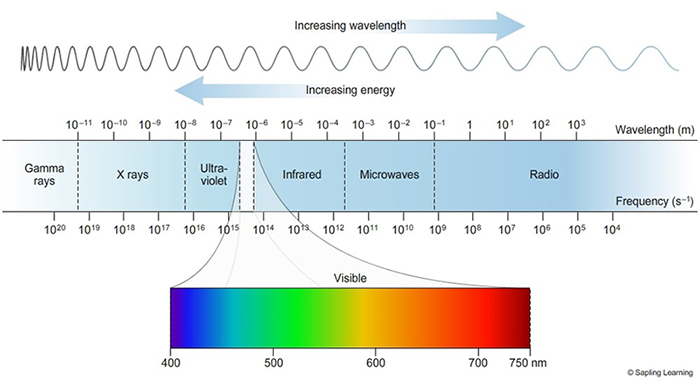Light, or visible light, is but a small portion of the electromagnetic spectrum that our eyes can detect. The visible light spectrum consists of wavelengths of light (from shortest to longest) violet, indigo, blue, green, yellow, orange, red, and travels from the sun at 186,000/miles per second before it strikes an object. Depending on the object it strikes, it will either absorb, reflect, or refract the light. As an example, let's use a red apple. When sunlight, or white light, strikes the apple, the component colors are broken down and all the wavelengths of light are absorbed with the exception of the red wavelengths; they are being reflected. As our eyes process this information and fine-tune this data, our brain interprets this, and we see that all the colors except red are absorbed by the apple. The red wavelength is reflected, and therefore the apple appears red.
 |
Now, notice the scenery around you. The sky is clear and flooded by a beautiful blue color and some clouds as you walk by your vibrant green lawn. Our prehistoric ancestors would have perceived this very differently. According to a 2014 research article “The Epistatic Adaptive Evolution of Human Color Vision” by S. Yokoyama, et al, 90 million years ago, our evolutionary predecessors had two simple photoreceptors, or cones, allowing them to detect ultraviolet and red wavelengths, and rods aiding in low-light conditions. With the ability to detect ultraviolet light, looking out into the atmosphere during the day would have caused visual discomfort. This is because ultraviolet wavelengths refract significantly more than blue. The sky would have looked extra blue, and there would have been a thick haziness in the atmosphere making it difficult to see clearly into the distance.
 |  |
| Present human vision | Vision with the ability to detect UV light |
During this time our predecessors were nocturnal, and their rods were plentiful compared to cones, as they are today. Rods helped detect even the smallest amounts of light, and larger pupils allowed in as much available light as possible to help detect motion during nighttime hours. This aided in survival from predators. Fast forward 40-65 million years. The extinction of most of the aerial predators allowed our ancestors as a species to thrive and evolve. Now their photoreceptors were able to evolve and detect an extended portion of the visible light spectrum. The ultraviolet photoreceptor shifted to detecting blue light (S-cone), and the red photoreceptor (L-cone) split, creating a new photoreceptor that enabled detection of green wavelengths as well (M-cone). Today we have about 6 million cones, densely packed in and around the fovea centralis, active during daytime (photopic vision), while we have about 120 million rods located everywhere else in the retina, active during low-light conditions (scotopic vision).
Our present acuity, motion detection and color sensation are the result of millions of years of evolution, changed from primarily nocturnal to daytime mammals, thus causing our eyesight to play a significant role in the evolution of our species. Something that most people—except those in our industry—may take for granted.
Learn how our brain interprets color from retinal signals with our CE, Wiley X Lens Technology Redefining Color with Captivate, at 2020mag.com/ce.













